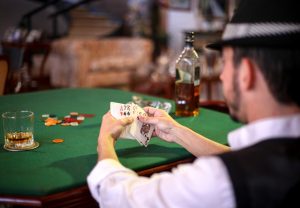It is based on a predetermined series of moves depending on your cards and the dealer. The “composition-dependent” strategy acts on a different dynamic. Instead of taking into account your and the dealer’s cards, it also takes into account the cards of the other players and those still in the deck. Let’s take a closer look.
 The “Dependent Composition” In Action
The “Dependent Composition” In Action
The composition dependent strategy is ideal for more experienced blackjack players who want to have a better house edge. When used correctly, the dependent composition can help reduce the house advantage to 0.5%. The thing to remember is that composition-dependent strategy changes as soon as the game changes, it is not static like totally dependent strategy. Suppose you are given a 10 and a three for a total of 13. If the dealer shows a two, the composition dependent strategy suggests hitting. Because? Because a 10 – the one in hand – was removed from the game. The risk of you breaking is reduced. On the other hand, if you get a 13 without a 10 and the dealer shows a 2, the composition dependent strategy says you should stand. The composition-dependent strategy works best in a multi-deck blackjack game where it is easier to figure out which cards are left in the shoe. Let’s take a deeper look.
Use Your Tables Wisely
It is a good idea to have two blackjack strategy tables handy when using a composition-dependent strategy: one for the totally dependent strategy and one for the composition-dependent strategy. A hard five in either strategy would suggest hitting, regardless of what the dealer reveals as a card. But if you hit a hard 12, the totally dependent strategy says to hit the dealer’s two, three, seven, eight, nine, 10, or A. With the Composition-Dependent strategy, the move depends entirely on how your hand is made. A 10 and a two is a suggested hit against the dealer’s two, three, four, seven, eight, nine, 10 or A (and one in five stand). A nine and three is a stand for a four, five, and six. Eight and four is a stand for multiple cards (three, four, five, and six), equal for a 12 made up of a seven and five. When it comes to doubling down, the composition dependent strategy is much more aggressive. As you can see from our table, it is recommended to double down on an 8 when the dealer is showing a five or six. It is these nuances that make composition-dependent strategy so interesting. same for a 12 consisting of a seven and five. When it comes to doubling down, the composition dependent strategy is much more aggressive. As you can see from our table, it is recommended to double down on an 8 when the dealer is showing a five or six. It is these nuances that make composition-dependent strategy so interesting. same for a 12 consisting of a seven and five. When it comes to doubling down, the composition dependent strategy is much more aggressive. As you can see from our table, it is recommended to double down on an 8 when the dealer is showing a five or six. It is these nuances that make composition-dependent strategy so interesting.
Try The Employee Composition Strategy At Betway Casino Today
If used well, the composition-dependent strategy can help reduce the house edge. Not by much, but just enough to make a difference to your long-term profits. It is important to keep track of what is happening at the table too. Follow the other players’ cards, remember what came out of the shoe, and make your move.

